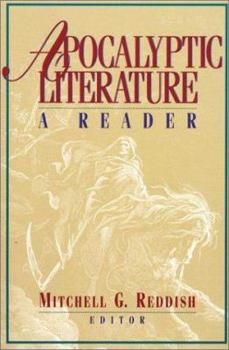Apocalyptic Literature: A Reader
Select Format
Select Condition 
Book Overview
Originally published: Nashville: Abington Press, c1990. This description may be from another edition of this product.
Format:Paperback
Language:English
ISBN:1565632109
ISBN13:9781565632103
Release Date:January 1996
Publisher:Hendrickson Publishers
Length:352 Pages
Weight:1.21 lbs.
Dimensions:0.8" x 6.1" x 9.1"
Customer Reviews
4 ratings
Best Place to Start for Studying Revelation
Published by Thriftbooks.com User , 15 years ago
If you want to become comfortable in the world of the New Testament book of Revelation, I suggest you start with this book. Reddish has selected and edited 25 Jewish and Christian Apocalypses in this book that will help the reader become more acquainted with the apocalyptic genre of writing. I used this book in a course on Revelation while at college. We read this book the first half of the semester, and then Revelation itself the second half. The similarities and nuances that one can pick up afterward is rather astonishing and helpful from an interpretative stand point. You need not agree with Reddish on all his view points to appreciate this book. It simply helps you to understand better the assumptions that apocalyptic carried with it when you approach Revelation.
An indispensable collection for beginning students
Published by Thriftbooks.com User , 15 years ago
James Charlesworth's Old Testament Pseudepigrapha (volume 1) is still the go-to general collection for Jewish apocalyptic literature, but it is too expensive and overwhelming, both in terms of its bulk and the academic style of its commentary, for the typical undergraduate student/beginner . Reddish's slim paperback really gets the job done for that student. It includes at least portions of every important apocalypse outside the Bible, both Jewish and Christian, in an accessible translation with a pertinent introduction for each book. Its scholarship is solid, but at the same time it doesn't confuse the introductory student with debates over points he/she is not yet ready to address. I've used this text in university classes with great success and recommend it highly.
Great Content - Suspect Introduction
Published by Thriftbooks.com User , 19 years ago
One of the challenges in biblical prophecy is separating style from substance. For example, in the Bible, when we read of the sun turning dark, the moon into blood, and the stars falling from the sky in Matt. 24:29, is this to be taken literally? Many Christian interpreters say yes. Others say no, it is simply apocalyptic language and cannot be used as a determiner in the sequence and timing of end-times events. I have recently become interested in the question of apocalyptic imagery, particularly as it relates to the sequences in Revelation, so I pulled a book off my shelf that I ordered long ago: Apocalyptic Literature, compiled and edited by Mitchell G. Reddish. From it, I hoped to get a sense for the apocalyptic writing style of the period that would give me some additional perspective. The collection of apocalyptic writings is chosen to represent different non-canonical apocalyptic writing styles in both ancient Jewish and Christian literature. But the introduction is something to be taken with a grain of salt, and if this text is used in undergrad coursework, it is presenting an extremely skewed viewpoint that is potentially as dangerous as it is inaccurate. The editor, Mitchell Reddish, adopts the view that all apocalyptic literature, including the canonical book of Daniel, was written ex eventu, or after the fact, by a writer using a pseudonym of an ancient historical figure, such as Moses, Abraham, or Daniel. This places all apocalyptic literature in the realm of human origins - works of fiction and imagination - and denying the possibility of divine inspiration. In other words, despite the internal evidence and the testimony of other ancient writers, the only way biblical writings could contain accurate prophecies is for them to have been written by imposters centuries later. Ironically, throughout the introduction to the book, Reddish repeatedly uses the term "God," as if he accepts the existence of a divine being, and he even refers to Jesus as "the Christ" and refers to His resurrection; and yet his evaluation of all apocalyptic literature, including the writings of the biblical canon, is that that it is nothing more than "protest writing" of human origin. Futurist interpretations of Revelation - or even any attempt to see these prophecies as literal, even in terms of historical fulfillment - are written off as foolisness. Although this book is a compilation of non-canonical literature, and therefore is not a direct attack on the inspiration of scripture, there is still a dangerous combination of fact and personal belief as it relates to all apocalyptic literature that is packaged as if it is ALL fact. His bias even goes so far as to indicate that most Christians who do venture to study Daniel and Revelation discover them so impenetrable that they give up all hope of finding any clarity within them. This is so blatantly untrue that it makes all of his other unverifiable statements suspect, as well. In a way, this remin
An excellent ajunct piece to the Bible
Published by Thriftbooks.com User , 22 years ago
I haven't read most of this book, but from what I have read, it is beautiful. I think it is books that were written when the Holy Bible was written, but they weren't included in the Bible because God did not want them there. This book is full of beautiful poetry about Enoch, Abraham, Moses, and other prophets of the old testement. If you are a Bible reader and want to know more about God and how He deals with mankind, this book is for you. I am excited to start reading it. You will find that the reading is not difficult and the authors of this writing paint pictures of what the world will be like when Jesus Christ comes to earth a second time.






